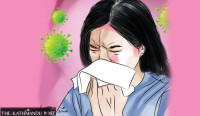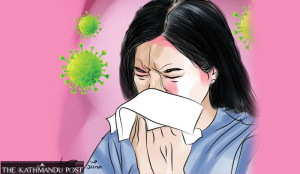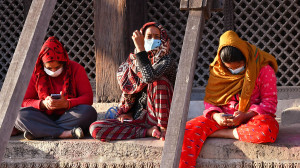Health
Air pollution is top cause of death and disability in Nepal
Filthy air cuts life expectancy by 3.4 years, causes around 26,000 premature deaths annually: World Bank report
Arjun Poudel
Air pollution has emerged as the number one risk factor for death and disability in Nepal, surpassing malnutrition and tobacco use, according to a new World Bank report.
The report titled, ‘Towards Clean Air in Nepal: Benefits, Pollution Sources, and Solutions,’ unveiled on Tuesday, stated that polluted air cuts life expectancy by 3.4 years for the average Nepali and causes approximately 26,000 premature deaths annually.
“Air pollution heavily contributes to various diseases: 75 percent of chronic obstructive pulmonary disease cases, 46 percent of strokes, 44 percent of ischemic heart disease, 41 percent of lower respiratory infections, 38 percent of lung cancer, 30 percent of neonatal issues like low birth weight and preterm birth, and 20 percent of diabetes,” reads the report.
Economically, the consequences are severe. “It affects labor productivity due to increased health-related absences and impaired cognition. The negative impact on the tourism industry and the aviation sector is also significant. The economic cost of poor air quality is estimated to exceed six percent of Nepal’s GDP each year,” the report says.
Over the past decade, growing air pollution has emerged as a major public health problem in Nepal. Kathmandu Valley and the Tarai are Nepal’s air pollution hotspots, with no significant improvement seen over the past decade.
The main sectoral sources of air pollution in the Valley are industrial production, cooking, and mobility, and these will remain dominant over the next decade unless further action is taken, according to the report.
Industrial fuel combustion — led by boiler usage — is expected to increase significantly. Forest fires dominate during the dry months (February to May) and constitute the fourth largest local source of annual average air pollution exposure, the most relevant metric for adverse impacts on public health. Transboundary air pollution significantly impacts air quality in both Kathmandu Valley and in the Terai region.
The study shows a quarter of the pollution in the Kathmandu Valley comes from outside the Valley and more than half of that from outside of the country. Despite being surrounded by hills, the valley experiences pollution transported from regional sources, as wind patterns and atmospheric conditions carry pollutants into the area.
In the Tarai, pollution coming from across the border is even more dominant, largely driven by its geographic proximity to other countries in the Indo-Gangetic Plain Himalayan Foothills. Two thirds of PM2.5 exposure in the Tarai comes across the international borders, a region with high agriculture and industrial emissions.
If no additional measures are taken, the report warns, air pollution will worsen significantly by 2035. Under the baseline scenario, average PM2.5 concentrations will reach 52 µg/m³ in Kathmandu Valley and 42 µg/m³ in the Tarai, far above the World Health Organisation’s interim target of 35 µg/m³.
These levels would result in tens of thousands of additional premature deaths, particularly impacting children and the elderly, a further strain on the healthcare system, and a growing drag on productivity and competitiveness.
Without intervention, the economic burden is also expected to grow proportionally, the report warns, while calling for multi-sectoral and multi-regional actions.
To address the crisis, the World Bank calls for continuing the electrification of vehicle fleets, including cars, motorcycles, buses, and trucks along with stricter vehicle inspection and maintenance systems, and reducing road dust.
The report suggests that support for cleaner technology and fuel adoption in industries— including electric and pellet boilers and furnaces in small and medium enterprises—will help promote cleaner industries. Industrial facilities such as brick and cement factories also need to be supported to burn cleaner and more efficient fuels.
Similarly, supporting households to adopt cleaner and, preferably, electric cookstoves is key to cutting household sources of air pollution. Biomass-fueled stoves create both indoor and ambient air pollution.
The report also stresses the importance of forest fire prevention through fuel load management, awareness programmes, and improved response systems to reduce the frequency and intensity of forest fires.
Likewise, an effective partnership with neighbouring countries is also critical. Transboundary airflows carry pollutants across borders. The Indo-Gangetic Plain and Himalayan Foothills Region share an airshed, meaning that pollutants can travel across borders, affecting air quality in multiple countries.
Nepal’s unique geographical location, particularly the bowl-shaped Kathmandu Valley surrounded by mountains, exacerbates the problem.
“Single sector solutions are not sufficient to meet any clean air target; thus, public policy and investment need to optimise air quality actions across sectors, prioritising the most cost-effective solutions,” stated the report.
Experts ask the authorities concerned to take the findings seriously and to take urgent measures to address the growing burden of air pollution.
Air quality expert Bhusan Tuladhar called growing air pollution a public health crisis. “Most of us are aware of the crisis and have personally been affected. So we must act with urgency to address the problems.”
Doctors say the key pollutant of concern for human health is Particulate Matter (PM) smaller than 2.5 microns (i.e. PM2.5), due to its ability to penetrate deeply into the lungs and other vital organs. They say poor air quality can have short- and long-term effects on public health.
In the short term, it can lead to pneumonia, bronchitis, conjunctivitis, skin allergy, stroke, and heart problems. In the long run, it can contribute to severe conditions like ulcers, cancer of the lungs and intestines, kidney disease, and heart complications.
Past studies also show that Nepal had the world’s highest age-standardised death rates for chronic lung disease caused by air pollution in 2019—182.5 per 100,000 population—with 3318.4 years lost due to ill health or disability.
According to a past study carried out by the Nepal Health Research Council, the prevalence of COPD surpassed all non-communicable diseases—coronary artery disease, diabetes, and kidney disease—in the country. The problem was responsible for 16.3 percent of the total deaths in 2019, an increase from 6.1 percent in 1990.




 14.12°C Kathmandu
14.12°C Kathmandu












%20(1).jpg&w=300&height=200)

